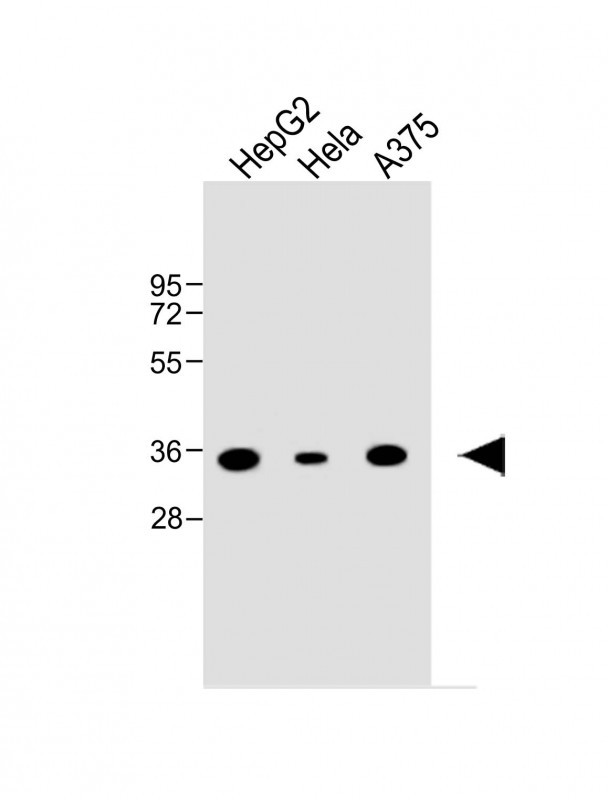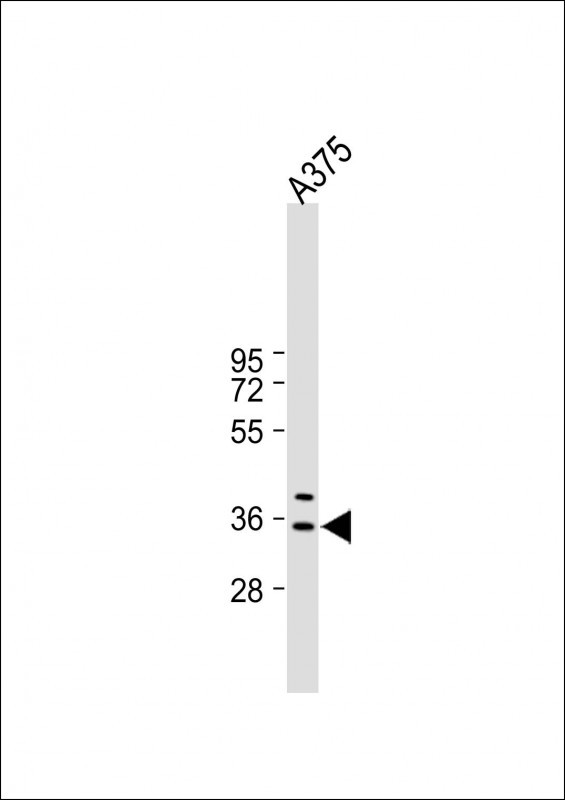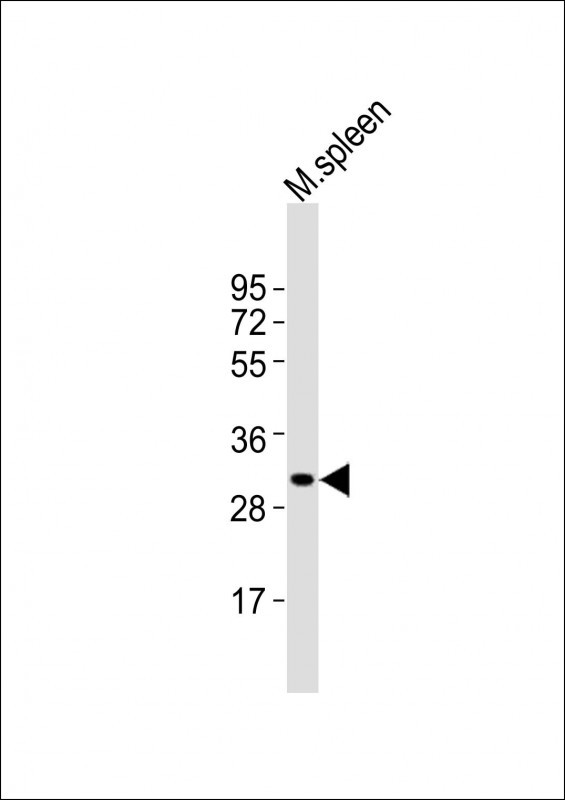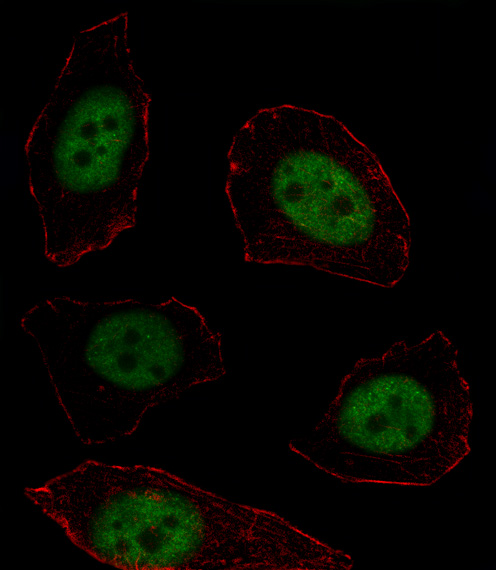MSX1 Antibody (Center)
Affinity Purified Rabbit Polyclonal Antibody (Pab)
- 产品详情
- 实验流程
- 背景知识
Application
| WB, IF, E |
|---|---|
| Primary Accession | P28360 |
| Other Accession | O02786, NP_002439.2 |
| Reactivity | Human, Rat, Mouse |
| Predicted | Bovine |
| Host | Rabbit |
| Clonality | Polyclonal |
| Isotype | Rabbit IgG |
| Calculated MW | 31496 Da |
| Antigen Region | 111-138 aa |
| Gene ID | 4487 |
|---|---|
| Other Names | Homeobox protein MSX-1, Homeobox protein Hox-7, Msh homeobox 1-like protein, MSX1, HOX7 |
| Target/Specificity | This MSX1 antibody is generated from rabbits immunized with a KLH conjugated synthetic peptide between 111-138 amino acids from the Central region of human MSX1. |
| Dilution | WB~~1:1000 IF~~1:200 E~~Use at an assay dependent concentration. |
| Format | Purified polyclonal antibody supplied in PBS with 0.05% (V/V) Proclin 300. This antibody is purified through a protein A column, followed by peptide affinity purification. |
| Storage | Maintain refrigerated at 2-8°C for up to 2 weeks. For long term storage store at -20°C in small aliquots to prevent freeze-thaw cycles. |
| Precautions | MSX1 Antibody (Center) is for research use only and not for use in diagnostic or therapeutic procedures. |
| Name | MSX1 (HGNC:7391) |
|---|---|
| Function | Acts as a transcriptional repressor (By similarity). Capable of transcription autoinactivation (By similarity). Binds to the consensus sequence 5'-C/GTAAT-3' in downstream activin regulatory elements (DARE) in the gene promoter, thereby repressing the transcription of CGA/alpha-GSU and GNRHR (By similarity). Represses transcription of myoblast differentiation factors (By similarity). Binds to core enhancer regions in target gene promoters of myoblast differentiation factors with binding specificity facilitated by interaction with PIAS1 (By similarity). Regulates, in a stage-specific manner, a developmental program of gene expression in the fetal tooth bud that controls odontoblast differentiation and proliferation of dental mesenchymal cells (By similarity). At the bud stage, required for mesenchymal molar tooth bud development via facilitating reciprocal signaling between dental epithelial and mesenchymal cells (By similarity). May also regulate expression of Wnt antagonists such as DKK2 and SFPR2 in the developing tooth mesenchyme (By similarity). Required for BMP4 expression in dental mesenchyme cells (By similarity). Also, in response to BMP4, required for BMP4 expression in neighboring dental epithelial cells (By similarity). Required for maximal FGF4-induced expression of SDC1 in dental mesenchyme cells (By similarity). Also in response to SDC1, required for SDC1 expression in neighboring dental epithelial cells (By similarity). At the early bell stage, acts to drive proliferation of dental mesenchyme cells, however during the late bell stage acts as an homeostatic regulator of the cell cycle (By similarity). Regulates proliferation and inhibits premature mesenchymal odontogenesis during the bell stage via inhibition of the Wnt signaling component CTNNB1 and subsequent repression of the odontoblast differentiation factors BMP2, BMP4, LEF1, ALPL and BGLAP/OCN (By similarity). Additionally, required for correct development and fusion of the palatal shelves and embryonic mandibular formation (By similarity). Plays a role in embryonic bone formation of the middle ear, skull and nasal bones (By similarity). Required for correct formation and thickness of the nail plate (By similarity). May play a role in limb-pattern formation (By similarity). |
| Cellular Location | Nucleus {ECO:0000250|UniProtKB:P13297}. Note=Interaction with PIAS1 is required for localization to the nuclear periphery (By similarity). {ECO:0000250|UniProtKB:P13297} |
For Research Use Only. Not For Use In Diagnostic Procedures.
Provided below are standard protocols that you may find useful for product applications.
BACKGROUND
This gene encodes a member of the muscle segment homeobox gene family. The encoded protein functions as a transcriptional repressor during embryogenesis through interactions with components of the core transcription complex and other homeoproteins. It may also have roles in limb-pattern formation, craniofacial development, particularly odontogenesis, and tumor growth inhibition. Mutations in this gene, which was once known as homeobox 7, have been associated with nonsyndromic cleft lip with or without cleft palate 5, Witkop syndrome, Wolf-Hirschom syndrome, and autosomoal dominant hypodontia.
REFERENCES
References for protein:
1.Sliwinski, T., et al. Cancer Epidemiol 34(5):652-655(2010)
2.Nikopensius, T., et al. Birth Defects Res. Part A Clin. Mol. Teratol. 88(9):748-756(2010)
3.Suazo, J., et al. Am. J. Med. Genet. A 152A (8), 2011-2016 (2010) :
4.Doi, T., et al. J. Pediatr. Surg. 45(6):1187-1191(2010)
5.Jugessur, A., et al. PLoS ONE 5 (7), E11493 (2010)
References for SY5Y (SH-SY5Y; ATCC#CRL-2266): 1. Ross RA, et al. Coordinate morphological and biochemical interconversion of human neuroblastoma cells. J. Natl. Cancer Inst. 71: 741-749, 1983. [PubMed: 6137586]; 2. Biedler JL, et al. Multiple neurotransmitter synthesis by human neuroblastoma cell lines and clones. Cancer Res. 38: 3751-3757, 1978. [PubMed: 29704].
终于等到您。ABCEPTA(百远生物)抗体产品。
点击下方“我要评价 ”按钮提交您的反馈信息,您的反馈和评价是我们最宝贵的财富之一,
我们将在1-3个工作日内处理您的反馈信息。
如有疑问,联系:0512-88856768 tech-china@abcepta.com.























 癌症的基本特征包括细胞增殖、血管生成、迁移、凋亡逃避机制和细胞永生等。找到癌症发生过程中这些通路的关键标记物和对应的抗体用于检测至关重要。
癌症的基本特征包括细胞增殖、血管生成、迁移、凋亡逃避机制和细胞永生等。找到癌症发生过程中这些通路的关键标记物和对应的抗体用于检测至关重要。 为您推荐一个泛素化位点预测神器——泛素化分析工具,可以为您的蛋白的泛素化位点作出预测和评分。
为您推荐一个泛素化位点预测神器——泛素化分析工具,可以为您的蛋白的泛素化位点作出预测和评分。 细胞自噬受体图形绘图工具为你的蛋白的细胞受体结合位点作出预测和评分,识别结合到自噬通路中的蛋白是非常重要的,便于让我们理解自噬在正常生理、病理过程中的作用,如发育、细胞分化、神经退化性疾病、压力条件下、感染和癌症。
细胞自噬受体图形绘图工具为你的蛋白的细胞受体结合位点作出预测和评分,识别结合到自噬通路中的蛋白是非常重要的,便于让我们理解自噬在正常生理、病理过程中的作用,如发育、细胞分化、神经退化性疾病、压力条件下、感染和癌症。







_-_SY5Y.jpg)





